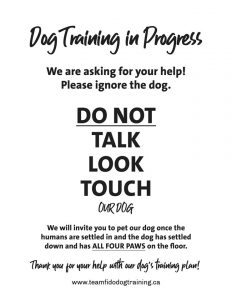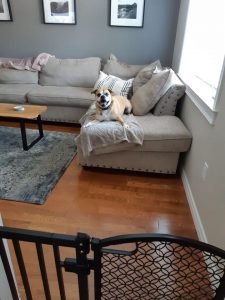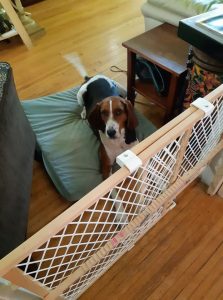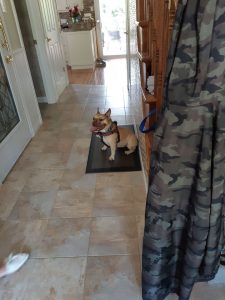Many dogs struggle with doorway greetings. It’s so much fun there! We go out the door for walks, for play, and new exciting people come in the door. We have inadvertently created a “zone of excitement”!
It’s important that we understand our dogs aren’t being bad. They are being excited! We want to teach them to do something else at the door instead of jumping and barking, an alternate behavior that is more rewarding to them and ultimately us as well.
First off, we need to stop yelling, scolding, using a lot of words like stop, off, down and NO that aren’t giving the dog any direction. They are actually getting the dog more excited, us more frustrated, and the behavior worse.
One of the first things I recommend is putting a sign on the door. I have these available at the training hall, or you can make one yourself. It helps that your guests understand that you are training, and they will stop and think and ask questions about what they should do. It makes a big difference!
We need to practice our response to doorway greetings ahead of time, so when you need to use our new plan your dog already knows what to expect. We also need to start to desensitize our dogs to the sound of the doorbell and knocking. Other important things to work on to prepare; practice your recall, and have frozen stuffed Kongs always ready in the freezer!
I like to have a Plan A, Plan B, and Plan C to cover different circumstances.
Plan A – When you are expecting guests.
Plan B – When someone comes to the door unexpectedly, and they stay to visit.
Plan C – When you are getting a delivery.
Plan A -When you are expecting guests
Have your guest call or text you when they are 5 min away. Call your dog into the space you have designated for them. This could be a hallway or a room off of your entryway where you can put up a baby gate. We want our dogs to see/hear and smell but not be right at the door. Give your dog a stuffed frozen Kong or similar awesome reward to work on. This will keep them occupied when someone comes, it will also help create a positive association for dogs that are anxious or fearful. After 15 or 20 mins when the guests have settled in you can let your dog out if he/she is relaxed and calm. If your dog is anxious or fearful they may be more comfortable just to stay in their own area, and that is fine.
Plan B – When someone comes to the door unexpectedly, and they stay to visit
Someone shows up that you weren’t expecting, and your dog runs barking to the door. You call through the door “I will just be a minute!” (Remember, you will have a sign on the door explaining that you are training) and call your dog back to your designated dog spot. Put up the baby gate. Grab a stuffed frozen Kong and give it to your dog. Then go to the door to let you guest in. Then, same scenario as Plan A.
Plan C- When you have a delivery
This looks much like Plan B. You just need to sign for or take a package. Your dog can stay in the designated spot until you shut the door.
I don’t recommend using a crate for this, as your dog can feel trapped and this can escalate fear, anxiety or stress. Your dog needs to feel like he can move away from the gate if he is uncomfortable.
Above are some examples of how to set up the spot for your dog. Below is an example of what we would start training next, which would be your dog in a stay on a mat near the door. Use the baby gate for as long as needed, to make sure your dog can stay calm when around the doorway. Remember to keep calm, and reward good behavior 🙂
For more information or to book a consultation, contact Team Fido Dog Training at www.teamfidodogtraining.ca




